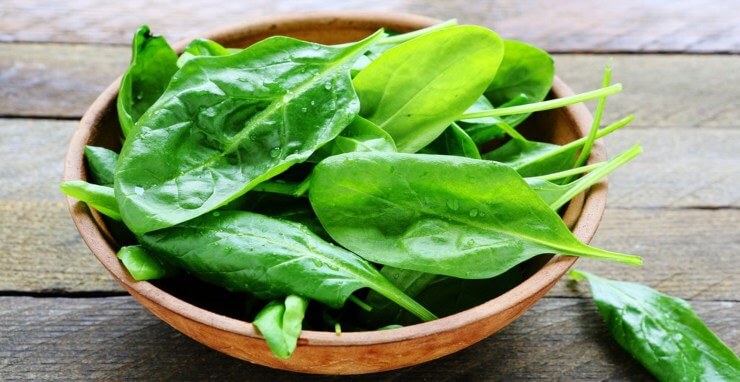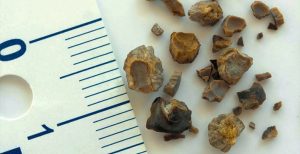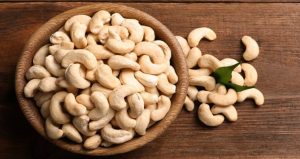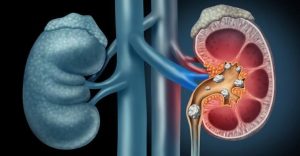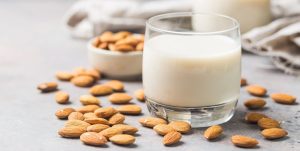If you are predisposed to kidney stones or have high oxalate in your urine, you should be careful about how much and how often you consume spinach.
This is because spinach, loaded with oxalate, can increase your urinary oxalate levels and thus raise your risk of forming calcium oxalate kidney stones.
In this article, we’ll closely examine the relationship between spinach consumption and kidney stones.
Spinach and Kidney Stones
There are four main types of kidney stones; calcium oxalate, uric acid, struvite and cystine stones.
While excess consumption of spinach can raise the risk of developing calcium oxalate stones, this healthy green vegetable doesn’t influence the formation of other types of kidney stones.
Calcium oxalate stones are by far the most common type, accounting for about 70% of all stones, according to epidemiological studies {1, 2, 3}.
As the name implies, calcium oxalate stones are composed of calcium and oxalate, a molecule present in many foods.
If your urine contains high levels of oxalate and too little liquid, calcium and oxalate can stick together and form stones.
For this reason, people who are at risk for calcium oxalate stones are advised to drink plenty of fluid (mostly water) and limit the consumption of foods high in oxalate.
Spinach is one of the highest sources of oxalate! That is why people who are prone to calcium oxalate stones are often advised to avoid or limit spinach consumption.
Limiting the intake of foods high in oxalates such as rhubarb, spinach, and chocolate may be beneficial for people with a history of calcium oxalate stones, indicates National Kidney Foundation.
How Much Oxalate is in Spinach?
As per the list published by the Harvard T.H. Chan School of Public Health Nutrition; half a cup of cooked spinach contains approximately 750 mg of oxalate.
Note that none of the foods on the list contains more oxalate than spinach! So it should be safe to say that spinach is extremely rich in oxalate.
If you are at risk for oxalate stones, your doctor may advise you to limit your oxalate intake. This is called a low oxalate diet. According to different sources, a low oxalate diet involves eating less than 100mg of oxalate — ideally about 50 mg — a day {4, 5, 6}.
A study published in the Journal of the American Society of Nephrology suggests that spinach alone may account for about 40% of oxalate intake in the US.
Some People Appear to Absorb More Oxalate
Researchers speculate that the reason some people develop calcium oxalate stones is less about how much oxalate they eat, and more about how much oxalate they absorb.
Simply put, researchers suggest that some people genetically absorb more dietary oxalate than others {7, 8, 9}.
They are called “super absorbers”. According to the researchers; super absorbers can absorb up to 50% more dietary oxalate than people who don’t form calcium oxalate stones {9, 10}.
This can be the reason why the recurrence rate of calcium oxalate stones is high, and why people with a history of calcium oxalate stones are often advised to limit the intake of foods high in oxalates such as spinach, rhubarb, and almonds.
Beware of Spinach Consumption If You Have:
There are certain factors that may increase your oxalate absorption and thus raise your chance of developing calcium oxalate stones.
Eating too much spinach when you have one or more of the below-given risk factors may increase the likelihood for you to develop calcium oxalate stones.
- Certain diseases: Studies suggest that people with inflammatory bowel disease, such as Crohn’s disease, are more likely to develop kidney stones because their bodies tend to absorb more oxalate {11, 12, 13}.
- Gastric bypass Surgery: Studies demonstrate that gastric bypass surgery (a type of weight-loss surgery) can impair oxalate absorption within the gastrointestinal tract, thus raising the level of oxalate in the urinary tract, and increasing the risk of calcium oxalate stones {14, 15, 16, 17}.
- Long-term Antibiotic Use: Researchers suggest that prolonged use of certain types of antibiotics can decrease friendly bacteria called Olaxabacter Formigenes that help get rid of oxalate and therefore increase the risk of calcium oxalate stones {18, 19, 20}.
- Vitamin C supplements: Because at high doses vitamin C is metabolised into oxalate in the body, ingesting more than 500 mg of vitamin C daily is associated with an increased risk of calcium oxalate stones {21, 22, 23}.
Should You Avoid Spinach To Prevent Kidney Stones?
Whether you should consume spinach — and if so how much — while you are at the risk for calcium oxalate stones should be determined by your doctor!
Bear in mind that if you have had calcium oxalate stones or if there is too much oxalate in your urine, your doctor may advise you to avoid eating spinach.
Doctors say that even those who aren’t susceptible to kidney stones may develop stones if they eat too much spinach (cups a day) every day.
“Spinach has hundreds of milligrams…hundreds in a single serving. If you eat a lot of it, yes, you can get kidney stones,” says Fredric Coe, MD, a kidney specialist at the University of Chicago Medicine.
“A large amount of oxalate acid can set up kidney stones and other problems. And, so, spinach, in general, should probably not be eaten more than like twice a week” said Dr Michael Klaper, an American physician, and vegan health educator.
Conclusion: Eating spinach in moderation seems to be safe for those who aren’t predisposed to kidney stones. However, those with a history of calcium oxalate stones should consult their doctor or dietitian about their diet.
Tips to Make Spinach Consumption Less Risky For Stone Formers
The below-given tips might make eating spinach less risky for kidney stone formers.
Consume Spinach with Calcium: Reducing your dietary calcium intake may seem logical to lower the risk of forming calcium oxalate stones. After all, calcium oxalate stones occur when calcium combines with oxalate in the urine. But the opposite is true!
According to kidney stone experts, kidney stone formers should eat enough calcium (around 1,200 milligrams daily) so that calcium binds with oxalate in the stomach or intestines and leave the body in faeces {24, 25, 26}.
So, consider eating a calcium-rich food or beverage such as cheese or milk when you consume spinach. This can help reduce the amount of oxalate moving to your kidneys.
Pair Spinach with Lemon: Kidney stone specialists suggest that citrate (found in lemon and lime in great quantities) may lower the risk of kidney stones by preventing calcium from combining with oxalate in the urine {27, 28, 29}.
Cooking Spinach May Reduce Oxalate: According to a 2005 study published in the Journal of Agriculture and Food Chemistry, steaming spinach can reduce its oxalate levels by about 30 per cent while boiling can reduce its oxalate levels by more than 50 per cent.
This is probably because oxalate is leached into the cooking water when boiling the spinach.
The Bottom Line
A nutrient powerhouse spinach can benefit your health in many ways.
However, spinach may have a couple of adverse effects on some people with certain health conditions.
When eaten in excess, spinach can increase the risk of forming calcium oxalate stones in those who are susceptible to them due to its high oxalate content.
As mentioned earlier, calcium oxalate kidney stones are very likely to recur without preventive measures.
So, if you have had calcium oxalate stones, consider working with a registered dietitian who specialises in a kidney stone diet. Thus, you may reduce the risk of forming diet-related kidney stones.
